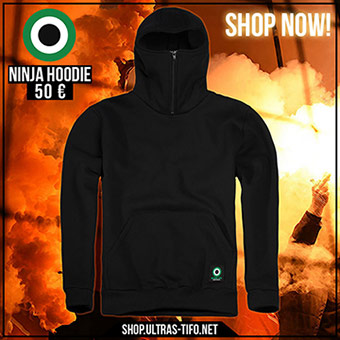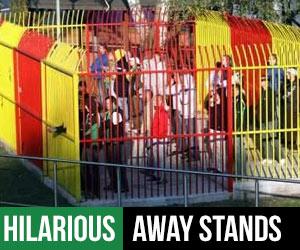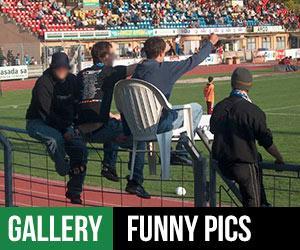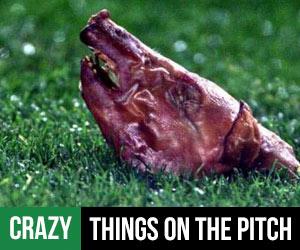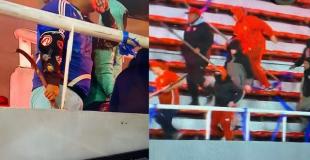Want to buy pyrotechnics? Visit pyro.ultras-tifo.net
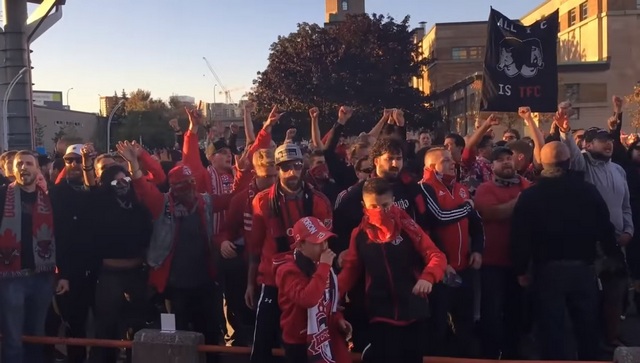
For better or worse, American football supporters are looking overseas for cultural inspiration as the sport becomes more and more popular in the country.
It’s true that soccer, or football as it’s called outside of the USA, is the world’s greatest game. Football is the most popular sport in the world, with over 3.5 billion people (or 43% of the world’s population) having an interest in it.
Although the US was reluctant to join the worldwide trend, during the last few decades, the sport has progressively gained popularity, with 24% of Americans claiming to be passionate about it.
What sparked the sudden interest in America?
Hosting the FIFA World Cup in 1994 and Major League Soccer’s (MLS’s) first season in 1996 both had a significant impact. Television networks’ decision to air English Premier League (EPL) matches in the United States, the rise in youth football participation, and the increased excitement surrounding both the men’s and women’s World Cups—as well as the national humiliation in 2017 when the U.S. men’s team fell short of qualifying for the World Cup for the first time in 24 years—are other likely contributing factors.
Much like the growing enthusiasm for football, entertainment options have expanded in other areas as well. Platforms like online casino seiten offer players a chance to explore diverse games and thrilling opportunities, providing an engaging experience for those looking to add excitement to their leisure time.
The demand to create a unique football-related culture has grown along with the sport’s growth in the US. Furthermore, the American football culture was mostly imported from elsewhere, just like a lot of other aspects of American society. A combination of “The Good, the Bad, and the Ugly” was the end result. Here, we’ll be speaking about the import of hooliganism by ultra organizations backing MLS clubs, which rates as “The Bad” here, yet what some of these promote can be rated as “The Ugly”.
But first, let’s talk about ultra organizations in the United States…
How Are Ultras Organized in the USA?
In North America, the game has created a distinct fan culture. There are loud and proud pure ultras groups as well, as evidenced by the fanbases of the Seattle Sounders, Portland Timbers, Atlanta United, Orlando City, Inter Miami, LAFC, and other teams.
There are organizations such as Inebriatti in Canada, who were banned by Toronto FC more than five years back – in the season in which they failed to defend the historical title for whose winning they weren’t the biggest favorites, just like Bayer Leverkusen took their first-ever German title recently despite being only the third-ranked championship favorite by Bookmaker Expert’s top-rated Bundesliga betting sites in 2024 – for instigating chaos during an Ottawa game. Wearing masks, they startled other spectators in the stadium by lighting smoke bombs and hurling flares onto the field. Their attendance at a Toronto FC game ended for good after that.
The Garden State Ultras had their status as the official supporting organization of the New York Red Bulls revoked early in 2018 after multiple complaints from other fans, stadium staff, and even the police. Inebriatti isn’t the first ultras group to have been banned by the team they represent. In June of 2018, members of Sector Latino, a Chicago Fire Ultras group, were also removed from their seats.
Some groups, like the San Jose Ultras, are still in the good books of the clubs they follow.
“The Bad”: Hooliganism Has Emerged
You may have had a (dramatized) glimpse of the occasionally violent football culture in the United Kingdom if you watched the 2005 film “Green Street Hooligans”. It goes without saying that England is particularly well-known for the brawls that frequently break out between opposing groups of supporters—passionate supporters of a particular team—but so-called hooliganism has spread throughout the globe, posing a serious threat to football culture.
Unfortunately to the MLS reputation, hooliganism has also crossed US borders as a result of America’s appropriation of international football culture, which began with innocuous chants and knit scarves. American sportswriters believe that Americans’ misplaced impulse to make football appear more genuine is to blame for the increasing incidence of hooliganism in the country. The pursuit of authenticity is leading to perilous outcomes.
Unfortunately, the American co-optation of world football culture hasn’t ceased with harmless shouts and knit scarves; hooliganism has also made its way across US borders.
Although the Third Rail may not consider themselves ultras, in the brief time that the club has been, NYC FC has had several ultras moments. For example, at a season opener in 2017, some fans tore seats out of Orlando City Stadium. That same year, there were also arrests for fighting in the streets surrounding the stadium. Also, back in 2015, fans of the New York Red Bulls and NYC FC were seen on camera fighting in the streets of downtown Newark, New Jersey. When football fans and the media made the connection between the faces in a street brawl and those seen in the stands at NYC FC home games, the arrest turned into a football controversy, and Major League Soccer was compelled to respond.
Actually, since NYC FC was founded in 2015, hooliganism has been a documented problem for the organization. Irvin Antillon’s 2018 incident, which happened off-site from the stadium, brought the team’s problems with the neo-Nazi group to light. An attacker on demonstrators outside the Metropolitan Republican Club in New York City was precisely Antillon, a member of the Latino skinhead group Batallón 49 (B49). The attack in October of 2018 attracted national notice. Fans informed the front office of NYC FC during the 2018 season that Antillon and B49 members had gone to games with members of the now-dissolved Proud Boys, a chauvinistic and violent club. While playing games, they frequently sported neo-Nazi attire. According to reports, Antillon and his friends were seated in the area meant for NYC SC, one of the two fan bases acknowledged by the team. He was prohibited from going to NYCFC events and games following his imprisonment.
In 2016, when a group of fans showed up to a Seattle Sounders game, the bulk of them were white, some had bandannas covering their faces, and some were waving green smoke flares. Why does this matter? They sang, “Take ’em all, Take ’em all, put ’em up against a wall and shoot ’em! Short and tall, watch ’em fall. Come on boys, take ’em all!’ in throaty unison. There was an odd British lilt to each of these phrases. A police officer in Orlando, Florida was attacked while attempting to break up a fight between opposing fans after an Orlando City Lions game in 2017.
While American football isn’t as violent as it is in Europe just yet, there’s worry that hooliganism could spread here as football becomes more and more popular.
“The Ugly”: Racism Plus Bigotry
It may surprise you to learn that altercations amongst football supporters aren’t even the worst part of the growing football culture in the US. Racism has consistently been a problem in international sports.
Although it’s not common yet, this disgusting conduct is slowly making its way into American football stadiums. Attendees of FC Dallas games used to experience bigotry from supporters when a player unexpectedly departed the team to play in Turkey. His departure caused great sadness among the supporters. Throughout the games, they chanted that they’d be better off without him and that terrorists and ISIS would take care of him. Officials from FC Dallas had to threaten to remove them permanently if they didn’t stop chanting that.
After the 2008 video of fans calling Zimbabwean forward Kheli Dube derogatory became widely shared, fans started harassing Dube and other black players, calling them the n-word.
There are factors other than racism at work. The custom of yelling the Spanish term “puto” at players on the other team originates from Mexican football matches. Concerns over its homophobic and sexist overtones are being raised by the fact that it’s becoming more prevalent during US matches. “Puta” (feminine) means “whore”, whereas “puto” (a guy who has sex with another man) denotes the same. If someone uses this to disparage a rival player, it implies that the player is not a true man and that it’s a negative thing to not be a man.
Efforts to Combat Racism
In the United States, there have been several initiatives to fight racism and discrimination in football. MLS started its “Don’t Cross the Line” campaign in 2017 with the goal of putting an end to homophobic, sexist, and racial remarks at games.
In 2020, the MLS revised its “Fan Code of Conduct” to include stronger guidelines and sanctions regarding the use of abusive, threatening, or discriminatory language, symbols, pictures, or gestures at league events.
Those two guidelines aren’t meant to be used for fan profiling or judgment. Its purpose is to oversee the conduct of American stadiums’ patrons and their interactions with one another. Thus, this was how the matter was handled at this point.
Now, it’s incredibly difficult to get support in MLS. It’s undoubtedly not the ideal setting for any kind of natural, organic support unlike it was prior to the introduction of the “Fan Code of Conduct”. For the members of those groups, opposing voices say, the prohibition is a godsend in disguise. Now that there’s no accountability, they are all far more free to do as they choose.
Conclusion
One may contend that the emergence of ultras groups is a protest against this regulated setting, which explains why Major League Soccer entered the ultras scene later than the majority of other international football leagues. Although MLS ultras groups aren’t as politically charged as many ultras groups in Europe, they are nonetheless political because they oppose the status quo that’s set by the league.
With average attendance currently comparable to those of Europe's top leagues, MLS has a diverse and varied fan base to match its popularity. Whether or not MLS can survive without ultras may not be the key question, but rather if their complete extermination is even a possibility.
